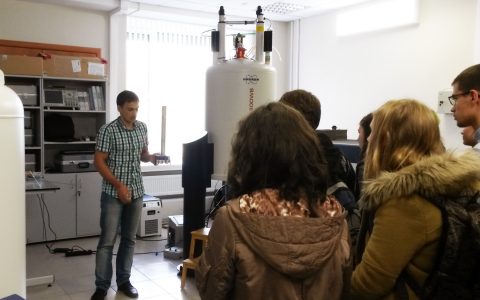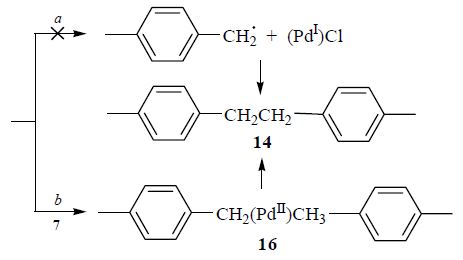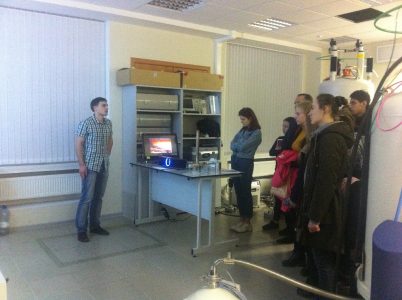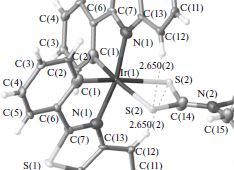
Michael Vovk has presented a lecture for students of Academic gymnasium. Our guests acquainted with the magnetic resonance research methods and modern equipment represented in CMR.
Excursion for high-school students
May
Total in May 1400 service applications were carried out.
All together measured:
- 1352 1H spectra
- 283 13C spectra
- 97 DEPT spectra
- 26 COSY spectra
- 6 NOESY spectra
- 58 31P spectra
- 48 19F spectra
168 applications were carried out.
Russ. J. Gen. Chem., 2016, 85(11), 2541-2546
S.A. Kras’ko, S.S. Zlotskii, V.P. Boyarskii
“Comparative Activity of Aryl, Alkyl, and Cycloalkyl Halides in the Suzuki Reaction Catalyzed with Acyclic Diaminocarbene Complex of Palladium”
Russ. J. Gen. Chem., 2016, 85(11), 2541-2546
DOI:10.1134/S1070363215110079
Relative activity of halogenated arenes, alkanes, and alkanes in the Suzuki reaction catalyzed with acyclic diaminocarbene complex of palladium has been investigated. Under all the investigated conditions, 4-iodoanisole has been more active than the alkyl halides. The reaction with 4-methyl-1-(chloromethyl)benzene has afforded the target 4-methyl-1-(phenylmethyl)benzene along with significant amount of by-products; other alkyl and cycloalkyl halides do not participate into the cross-coupling reaction. Ethanol has been found the most suitable solvent for the reaction. The reaction in acetonitrile provides noticeable yield of the products only in the presence of polyethylene glycol and water.
Separation Sci. Tech., 2016, 51(7), 1103-1111
D.N. Konshina, V.V. Open’ko, Z.A. Temerdashev, A.A. Gurinov, V.V. Konshin
“Synthesis of novel silica-gel-supported thiosemicarbazide and its properties for solid phase extraction of mercury”
Separation Sci. Tech., 2016, 51(7), 1103-1111
DOI:10.1080/01496395.2016.1143005
A new thiosemicarbazidе-modified silica gel (SG-THSC) sorbent was prepared. The sorbent was quantified by adsorption of mercury ions on silica gel, desorption and then spectrophotometry detection of mercury ions. The retention parameters (sample flow rate, eluent type, sample volume, presence of foreign ions, shaking time, sample flow rate and volume, eluent condition, interfering substances) were investigated. The quantitative recovery (>95%) of Hg(II) ions could be obtained by use of 5 mL of 6 mol L−1 HCl. The adsorption capacity of SG-THSC was found to be 98.3 mg g–1 at optimum pH. The maximum preconcentration factor was 400. The technique detection limit was 70 ng L–1, and the relative standard deviation was lower than 4.0% (n = 6). The studied sorbent was applied to preconcentrate the trace Hg(II) from the mineralised residues of fish and seawater samples.
Sci. Rep., 2016, 6, 24270
D.A. Markelov, V.V. Matveev, P. Ingman, M.N. Nikolaeva, A.V. Penkova, E. Lahderanta, N.I. Boiko, V.I. Chizhik
“Unexpected Temperature Behavior of Polyethylene Glycol Spacers in Copolymer Dendrimers in Chloroform”
Sci. Rep., 2016, 6, 24270
DOI:10.1038/srep24270
We have studied copolymer dendrimer structure: carbosilane dendrimers with terminal phenylbenzoate mesogenic groups attached by poly(ethylene) glycol (PEG) spacers. In this system PEG spacers are additional tuning to usual copolymer structure: dendrimer with terminal mesogenic groups. The dendrimer macromolecules were investigated in a dilute chloroform solution by 1H NMR methods (spectra and relaxations). It was found that the PEG layer in G = 5 generations dendrimer is “frozen” at high temperatures (above 260 K), but it unexpectedly becomes “unfrozen” at temperatures below 250 K (i.e., melting when cooling). The transition between these two states occurs within a small temperature range (~10 K). Such a behavior is not observed for smaller dendrimer generations (G = 1 and 3). This effect is likely related to the low critical solution temperature (LCST) of PEG and is caused by dendrimer conformations, in which the PEG group concentration in the layer increases with growing G. We suppose that the unusual behavior of PEG fragments in dendrimers will be interesting for practical applications such as nanocontainers or nanoreactors.
Beilstein J. Org. Chem., 2015, 11, 373-384
N.A. Danilkina, P.S. Vlasov, S.M. Vodianik, A.A. Kruchinin, Y.G. Vlasov, I.A. Balova
“Synthesis and chemosensing properties of cinnoline-containing poly(arylene ethynylene)s”
Beilstein J. Org. Chem., 2015, 11, 373-384
DOI:10.3762/bjoc.11.43
Novel poly(arylene ethynylene)s comprising a cinnoline core were prepared in high yields via a three-step methodology. A Richter-type cyclization of 2-ethynyl- and 2-(buta-1,3-diynyl)aryltriazenes was used for cinnoline ring formation, followed by a Sonogashira coupling for the introduction of trimethylsilylethynyl moieties and a sila-Sonogashira coupling as the polycondensation technique. The fluorescence of the cinnoline-containing polymers in THF was highly sensitive to quenching by Pd2+ ions.
Open Doors Day, Institute of Chemistry
Rus. J. Coord. Chem., 2016, 42, 178-186
E.A. Katlenok, A.A. Zolotarev, A.Yu. Ivanov, S.N. Smirnov, R.I. Baichurin, K.P. Balashev
“Complexes of Ir(III) and Pt(II) with Cyclometallated 2-Phenylbenzothiazole and Chelating Diethyldithiocarbamate and O-Ethyldithiocarbonate Ions: Structures and Optical and Electrochemical Properties”
Rus. J. Coord. Chem., 2016, 42, 178-186
DOI:10.1134/S1070328416030039
It is shown by X-ray diffraction analysis, IR spectroscopy, and 1Н, 13С{1H}, and 195Pt NMR spectroscopy that the Pt(II) and octahedral Ir(III) complexes with metallated 2-phenylbenzothiazole and chelating diethyldithiocarbamate and O-ethyldithiocarbonate ions have the square and cis-C,C structure, respectively. The highest occupied and lowest unoccupied molecular orbitals of the complexes determining their long-wavelength absorption, phosphorescence, and one-electron oxidation and reduction are assigned to those predominantly localized on the mixed p(S)/d(M) and π* orbitals of the metallated ligand. The cathodic shift of the oxidation voltammogram and the bathochromic phosphorescence shift of the Pt(II) complex with the О-ethyldithiocarbonate ion are attributed to the enhanced donor–acceptor interaction of the donor S atoms of the ligand with Pt(II). The structural data are deposited with the Cambridge Crystallographic Data Centre (CIF files CCDC nos. 1058768 (Ia) and 1058767 (IIb)).








